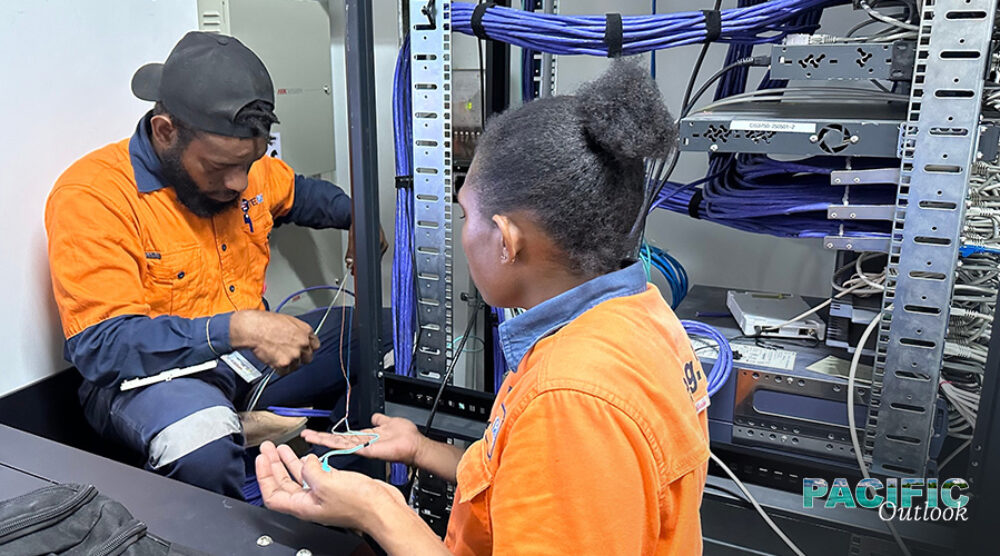KELERA ROGOIRUWAI AND KALOLAINI RANADI |
Introduction
International trade is critical to a country’s economic and social well-being. Advanced economies continue to leverage digital technologies such as artificial intelligence, machine learning, robotics, big data, and networks to transform production, meet external demands and boost growth. On the other hand, Pacific Island Countries (PICs) have long endured trade deficits due to a narrow export base with heavy reliance on few traditional commodities, geographical isolation and distance from global markets, and high trade costs. In this regard, there is scope for PICs to utilise digital technologies to reduce trade-related costs, improve competitiveness, diversify the consumer base, strengthen the resilience of supply chains, and boost participation in global trade markets.
Digital uptake in most PICs started to gain momentum in the mid-to-late 2000s (see Figures 1-4). This development was supported by various initiatives such as the liberalisation of the domestic telecommunications market which led to the entry of new service providers and spurred competition, deployment of submarine cables, funding support from bilateral and multilateral development partners, and government incentives to boost private sector investment, among other factors.

Against this backdrop, our study seeks to examine the role of digital technologies in enhancing trade in PICs. To test this, we apply the augmented gravity trade model with four available ICT indicators: mobile phone subscriptions, fixed telephone subscriptions, individuals using the Internet, and fixed broadband subscriptions.
Data
The study covered six PICs: Fiji, Papua New Guinea (PNG), Solomon Islands, Vanuatu, Tonga, and Samoa for the period 2000 to 2017. Data was sourced from the International Monetary Fund – the Direction of Trade Statistics (goods exports); World Bank Development Indicators (mobile phone rate, fixed phone rate, Internet rate, fixed broadband rate, trading partner and host countries Gross Domestic Product – GDP), and Centre d’Etudes Prospectives et d’Informations Internationales – CEPII (distance, language, and colonial ties).
Findings
Our findings on the links between ICT and goods exports in the six PICs are mixed. Although mobile phone devices offer greater mobility and flexibility than fixed landlines, we find a negative coefficient for mobile phone rates on goods exports of PICs. This demonstrates the significant variation in the development of the local mobile markets across PICs from 2000 to 2017, with penetration rates ranging from high (Fiji averaging 63.9 per 100 people) to low (PNG has the largest population relative to the rest of the PICs, with penetration of 19.6 per 100 people on average). Samoa has a mobile penetration of 36.7 per 100 people, Vanuatu has a rate of 34.9 per 100 people, and the Solomon Islands has a rate of 26.7 per 100 people. Also, the development of advanced ICT, supporting infrastructure (e.g., reliable electricity supply) and innovative environment to facilitate trade is often lacking given the substantial costs incurred due to the geographical isolation and dispersion of many islands in the PICs. We also find that fixed landline phone rate has a negative and significant relationship with exports of goods, indicating the shift in preference from fixed landlines towards wireless technologies in PICs.
On the other hand, both internet and fixed broadband rates positively influence goods exports. Among the ICT indicators, fixed broadband has the largest positive link with exports of goods, holding all other things constant.
In terms of other control variables, both trading partners’ and host country’s GDP coefficients are positive. Economic expansion in the host country leads to an improvement in infrastructure capacity and the ability of PICs to value add to production and trade. Moreover, the favourable economic performance of trading partners is crucial for PICs as it would mean more demand for merchandise exports of PICs.
Geographical distance to trading partners is a common natural barrier faced by PICs. This makes the costs of doing business with trading partners high and thus translates into lower goods exports. The existence of colonial ties between PICs and their trading partners, on the other hand, strengthened trade relations and increased goods exports. Against expectations, a common language shared between countries has a negative influence on goods exports.
Policy implications
The ability of PICs to increase their ICT investment is dependent on how effectively they comprehend targeted policies that can help unlock the latent potential of digital technologies to enhance trade. Some policy suggestions can focus on the following areas:
- Strengthen investment in ICT infrastructure to bridge the digital divide between rural and urban areas;
- Improve the quality of supporting infrastructure such as connecting households to reliable power supply;
- Encourage public-private partnerships and financial assistance from multilateral and bilateral development partners to enhance ICT investment;
- Develop digital upskilling and competencies; and
- Strengthen regulatory frameworks to adapt to evolving technologies.
Kelera Rogoiruwai is a Senior Economist, Reserve Bank of Fiji. Kalolaini Ranadi is a former Senior Economist, Reserve Bank of Fiji.
Please click here to read the full paper “Examining the impact of digital technologies on trade in Pacific island countries” published by Griffith Asia Institute.
The views expressed in this article are those of the author(s) and do not necessarily represent the position of the above-mentioned institution. For more information about Pacific island economies, visit Pacific Island Centre for Development and Policy Research.








